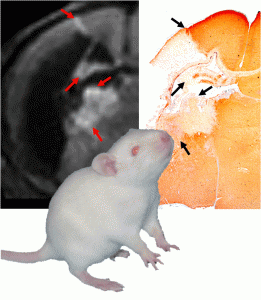Treatment with anti-inflammatories (the antibiotic doxycycline) appears to limit the damage resulting from hypoxic-ischemic brain injury among newborn, according to Cand.med. Marius Widerøe at the Department of Laboratory Medicine, Children’s and Women’s Health at NTNU.
The overall goal of the research is to find new treatments that can reduce brain injury among newborn babies.
“The hope is to find treatments that limit the damage, and reduce the problems for these children later in life,” Widerøe says.
“There is a lot about the brain, and especially brain injury among newborns, that we don’t know about. Over the last 30 years, we have increased our knowledge significantly, but there are still many unanswered questions.”
When injury occurs among newborn children, it happens at a stage when the brain is still not fully developed. This means that hypoxic-ischemic brain injury, in addition to damaging the brain’s structure, also impacts the development of the brain. At the same time, however, it gives rise to the possibility of the brain repairing itself and finding alternative methods for solving various tasks.
Using MRI
In his thesis, “Magnetic Resonance Imaging of Hypoxic-Ischemic Brain Injury Development in the Newborn Rat – Manganese and Diffusion Contrast,” Widerøe finds that the hypoxic-ischemic brain injury process continues for a prolonged period of time after the initial incident, but that anti-inflammatories such as the antibiotic doxycycline can limit the damage.
To map the injury process and treatment effect, Widerøe has developed and adopted new techniques for magnetic resonance imaging (MRI) in newborn animals. The use of MRI means that repeated examinations can be performed without biopsies, and researchers can follow the development in individual animals over a longer period.
The research group he belongs to also uses MRI to assess how too much or too little oxygen affects normal brain development.
It is in connection with this that the researchers have concluded that treatment with an anti-inflammatory gives a more normal brain development after a hypoxic-ischemic brain injury, compared with those who did not receive the same treatment.
The results also confirm previous research which shows that administering pure oxygen can cause further damage and delay maturing-processes in the brain further after an incident of lack of oxygen.
The research using rats will continue, and one of the PhD students in the group will look further into the harmful effects of oxygen in connection with hypoxic-ischemic brain injury. Other PhD students will look at treatments using stem-cells. Using MRI, the researchers can look at the movements of stem-cells in the brain after they have been implanted, and how these can affect inflammation-reactions and the brain’s ability to repair itself. As part of this, the group will continue to study the brain’s development using MRI.
While Widerøe’s part of the group primarily has focused on animal testing, another part of the group, directed by professors Ann-Mari Brubakk and Jon Skranes, has followed children with low birth weight and premature children using MRI and mapped their brain activity into adulthood. Many of these children have had small and/or large brain injury during pregnancy or birth, and the goal has been to follow their brain development and map the long-term effects of impacts around birth.
Viva
Marius Widerøe will defend his thesis on 29 May. A lecture will be given at 09.00 in the Auditorium at Medisinsk teknisk forskningssenter at NTNU. The viva will take place at 11.00.
Hypoxic-ischemic brain injury
Hypoxic-ischemia is a combination of reduced oxygen and limited blood supply to the brain. It is one of the most common causes of brain injury among newborn children and increases mortality, as well as psychological and physiological problems later in life.
Publications:
- Doxycycline treatment in a neonatal rat model of hypoxia-ischemia reduces cerebral tissue and white matter injury: a longitudinal magnetic resonance imaging study. Widerøe M, et.al.
- Longitudinal manganese-enhanced magnetic resonance imaging of delayed brain damage after hypoxic-ischemic injury in the neonatal rat. Widerøe M, et.al.
- Manganese-enhanced magnetic resonance imaging of hypoxic-ischemic brain injury in the neonatal rat. Widerøe M, et.al.

